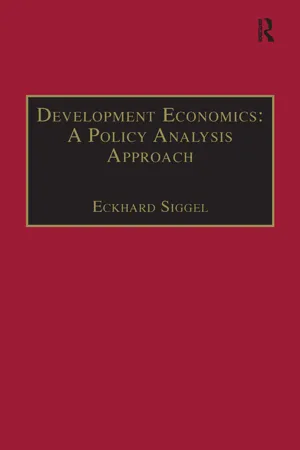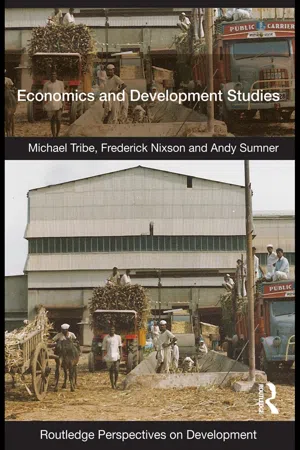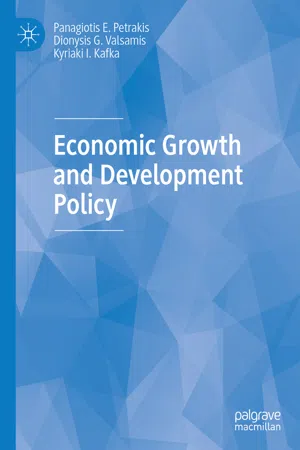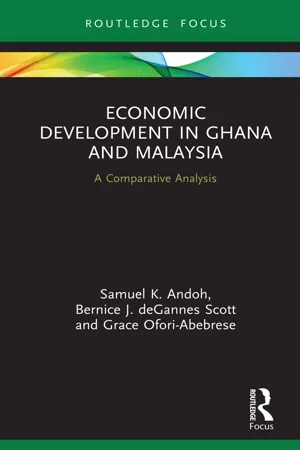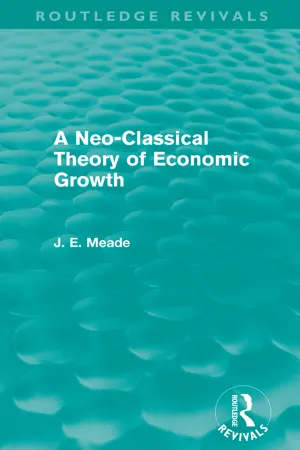Determinants of Growth
Determinants of growth refer to the various factors that influence the economic expansion of a country or region. These factors can include technological progress, human capital, natural resources, infrastructure, political stability, and institutional quality. Understanding and addressing these determinants is crucial for policymakers and economists seeking to promote sustainable economic growth and development.
8 Key excerpts on "Determinants of Growth"
- Eckhard Siggel(Author)
- 2016(Publication Date)
- Routledge(Publisher)
...Chapter 2 Economic Growth and its Determinants The analysis of economic growth has three purposes: (a) the measurement of the growth of various aggregates of the economy; (b) the identification and measurement of its determinants or sources; and (c) the prediction of future growth by help of growth models. We are interested in answering questions such as: What determines economic growth? Which factors make the most important contributions to growth, the factors of production or technical change? How can we predict economic growth? We have already seen in Chapter 1 how growth is measured, and will turn our attention now to models of growth. At first we discuss simple production function models, which allow us to analyze growth in terms of factor contributions and technical change under the name of growth accounting. In the next section we examine full-fledged macro models, which endogenize the accumulation of capital. Two members of this family are introduced, the Harrod-Domar model with fixed coefficients and the neoclassical (Solow) model, which allows for substitution between capital and labour. A short review of modem growth theory, often referred to as endogenous growth, concludes the theory, which is being applied in the last section to examine whether the international long-run experience with economic growth supports the hypothesis of convergence of income levels. 2.1 Production Function Models The question of what determines economic growth can be approached in various ways. In the production function approach we envisage the growth process entirely from the supply side. The growth of production is then described in the same way as the level of production, that is, by the combination of factors of production and their increase...
- eBook - ePub
- Vasileios Vlachos, Aristidis Bitzenis, Bruno S. Sergi, Vasileios Vlachos, Aristidis Bitzenis, Bruno S. Sergi(Authors)
- 2021(Publication Date)
- Emerald Publishing Limited(Publisher)
...Chapter 1 Determinants of and Obstacles to Economic Growth in Contemporary Greece Vasileios Vlachos, Aristidis Bitzenis and Bruno S. Sergi This new book aims to foster an in-depth understan ding of critical factors to Greece's economic growth. It will be a valuable guide to both those willing to identify the key factors to be considered for (modeling) sustainable economic growth and those interested in exploring the Greek economy's dynamics and performance. The objectives are to reveal these factors and discuss their importance in the current play: Greece's economic development after the great economic crisis and the COVID-19 crisis. The list of factors affecting economic growth in empirical research is extensive. Macroeconomic and external environment factors, governance and institutions indices, geographic indicators, and fixed factors (such as participation in conflicts) expand the list of traditional determinants of the augmented Solow model (Moral-Benito, 2012). The list may develop further by considering, for example, the findings of the literature linking entrepreneurship with economic growth, regarding the importance of both formal and informal institutional factors in shaping entrepreneurial activity and affecting through it the level of economic growth (Urbano, Aparicio, & Audretsch, 2019). Another example is social policy's role in enhancing social cohesion, which encourages capital accumulation and technological progress and can contribute to productive development (Chang, 2004). The empirical literature on the factors contributing to Greece's economic growth reveals several key determinants...
- eBook - ePub
- Michael Tribe, Frederick Nixson, Andy Sumner(Authors)
- 2010(Publication Date)
- Routledge(Publisher)
...However, we also know that institutional change and ‘qualitative’ changes (such as a better educated labour force) are also key factors accounting for economic growth, which are subject to influence by policy measures, rather than being ‘residuals’ which appear exogenously from outside the economic system. Although discussion about ‘endogenous growth’ may sometimes occur in an unsystematic manner, in a more political context it is encouraging that policy makers endeavour to understand the complexity of the factors which underlie economic growth and development. 4.5 Summary We have an approach to economic growth which suggests that the following factors are important influences: the level of savings and investment the rate of change of the capital stock the rate of technical change the rate of growth of the labour force the rate of enskillment of the labour force. The rate and type of institutional change also affects economic growth. Questions for discussion 1 How important do you consider economic growth to be as an objective of societies and of governments’ policies, particularly taking into account poverty reduction and environmental concerns in the early twenty-first century? 2 To what extent does economic growth depend upon significant savings and investment? 3 What is the role of technological progress in economic growth, and how is it included in the growth process? 4 How would you explain the differing economic growth experiences in recent decades between the countries of South East and East Asia and countries in sub-Saharan Africa? 5 How much does economic growth depend upon the luck of natural resource endowment and how much does it depend on good governance and public policy management? Suggested further reading Commission on Growth and Development. 2008. The Growth Report: Strategies for Sustained Growth and Inclusive Development...
- eBook - ePub
- Gerard Roland(Author)
- 2016(Publication Date)
- Routledge(Publisher)
...Underscoring the power of these two emerging economies, India and China together include more than one-third of the world population. It is important to distinguish between economic development and economic growth. Economic development refers to improvements in living standards and in the quality of life, while economic growth measures only growth in economic production. Economic growth may not accurately reflect all aspects of economic development because growth often results in negative effects on the quality of life such as pollution and urban congestion. Nevertheless, economic development cannot take place without economic growth. Growth is thus fundamental to development. I n this chapter, we introduce some important economic concepts to consider when discussing economic growth. We then review two very important theories of economic growth that explain the capital accumulation process. We will show that these theories, and others, based on capital accumulation explain only a small part of the differences in growth among countries. We then discuss the empirical evidence for the main causes of growth and highlight two important explanations for why some countries are so wealthy and others are so poor: geography and institutions. Currently, economists believe that institutions are central to understanding economic performance and economic growth in developing countries. The impact of institutions on growth will continue to inform our discussion of institutions throughout the remainder of the book. Growth and Factors of Production When we analyze the sources of economic growth, the first thing we must consider is the contribution made by the factors of production. Factors of Production Consider the output of a firm producing T-shirts. The firm generates output by combining labor and capital (machines, buildings, trucks). Labor and capital are critical factors in the creation of value and in the production of output in an economy...
- eBook - ePub
- Panagiotis E. Petrakis, Dionysis G. Valsamis, Kyriaki I. Kafka(Authors)
- 2020(Publication Date)
- Palgrave Macmillan(Publisher)
...© The Author(s) 2020 P. E. Petrakis et al. Economic Growth and Development Policy https://doi.org/10.1007/978-3-030-43181-5_5 Begin Abstract 5. The Determinants of Economic Policy Formation Panagiotis E. Petrakis 1, Dionysis G. Valsamis 1 and Kyriaki I. Kafka 1 (1) Department of Economics, National and Kapodistrian University of Athens, Athens, Greece Panagiotis E. Petrakis (Corresponding author) Email: [email protected] Dionysis G. Valsamis Email: [email protected] Kyriaki I. Kafka Email: [email protected] End Abstract 5.1 Introduction Economic science may formulate the determinants of economic growth, but it is the political system and the policy-makers who influence the outcome of the development process through their decisions. Shaping economic policy is a complex process that hinges on several determining factors. The area where economic policy-making occurs and where most decisions are made is politics (Sect. 5.2). So, we need to analyse the importance of the political function in economic policy formulation (Sect. 5.2.1), the role of pressure groups and elites (Sect. 5.2.2), the importance of multi-level governance (Sect. 5.2.3), networks, partnerships and agency theory (Sect. 5.2.4). Learning theories, diffusion and punctuated equilibrium (Sect. 5.3) are concepts that underlie economic policy theories, while disruptive innovations also play an essential role (Sect. 5.4). Institutions and cultural background (Sect. 5.5) have their share of responsibility and are therefore discussed in more detail later in the book (Chap. 7). Finally, we consider the behavioural approach to policy-making (Sect. 5.6). 5.2 Political Systems and the Formation of Economic Policy Political institutions are a way of allowing for the expression of individual preferences while balancing the collective conflicts that exist in society...
- eBook - ePub
Economics for Investment Decision Makers
Micro, Macro, and International Economics
- Christopher D. Piros, Jerald E. Pinto(Authors)
- 2013(Publication Date)
- Wiley(Publisher)
...The literature on economic growth focuses primarily on the role of capital and labor resources and the use of technology as sources of growth. In addition to these purely economic drivers, developed and developing countries differ with respect to the presence or absence of appropriate institutions that support growth. These institutions enable developing countries to raise their standards of living and eventually move into the ranks of the developed countries. We now examine some of the key institutions and requirements for growth.2.1. Savings and InvestmentOne of the major problems for some of the developing countries is a low level of capital per worker. Countries accumulate capital through private-sector and public-sector (e.g., infrastructure) investment. But increasing the investment rate may be difficult in developing countries because low levels of disposable income can make it difficult to generate significant saving. The low saving rate contributes to a vicious cycle of poverty: Low savings lead to low levels of investment, which leads to slow GDP growth, which implies persistently low income and savings. Therefore, it is very difficult to design policies to increase domestic saving and investment rates in developing countries. The good news is that the savings of domestic residents are not the only source of investment funds. A developing country can break out of the cycle of low savings by attracting foreign investment.2.2. Financial Markets and IntermediariesIn addition to the saving rate, growth depends on how efficiently saving is allocated within the economy. A role of the financial sector in any economy is to channel funds from savers to investment projects. Financial markets and intermediaries, such as banks, can promote growth in at least three ways...
- eBook - ePub
Economic Development in Ghana and Malaysia
A Comparative Analysis
- Samuel K. Andoh, Bernice J. deGannes Scott, Grace Ofori-Abebrese(Authors)
- 2020(Publication Date)
- Routledge(Publisher)
...4 Determinants of economic growth in Ghana Survey of the literature Introduction In Chapter 3, we reviewed some of the basic theories of economic growth. In this chapter, we survey the literature on the determinants of economic growth in Ghana with a view to identifying the specific ones that may have enhanced or inhibited growth. There are several academic works that have focused on the determinants of economic growth in Ghana. In this chapter we review a few of the studies. Growth strategy From independence, it was the plan of the new government to industrialize as quickly as possible and to do so using Ghanaian resources, both human and natural; it had plenty of the latter but not the former. The first attempts at industrialization involved the familiar import substitution industrialization (ISI). Between 1965 and 1983, several factories were established to produce consumer goods in order to reduce imports and to develop the base for manufacturing. To ensure that the factories succeeded, import restrictions were introduced and foreign exchange controls imposed. While the factories were set up to use local inputs, the supply chain had not been properly developed; it was not dependable and many of the factories found themselves with excess capacity. Most of the factories were set up to process agricultural products such as rice, copra, tomatoes and beef. This made a lot of sense, since Ghana was primarily an agricultural country. Unfortunately, the local supply of the raw materials proved to be unpredictable and together with the difficulty of obtaining foreign currency to import the raw materials, for the most part, the factories could not produce enough to meet local demand. In any event, the next stage of industrialization, exports of industrial goods, never materialized. By the time the economy became liberalized in in the 1980s, many of the factories were obsolete and the state enterprises that still remained were operating at losses...
- James E. Meade(Author)
- 2013(Publication Date)
- Routledge(Publisher)
...CHAPTER 2 Three Determinants of the Rate of Economic Growth So long as we maintain the assumption of perfect substitutability in production between capital goods and consumption goods (which we shall do until we reach Chapter 7 below), we are in fact dealing with a single-product economy, this product being useful for the two purposes of being consumed by consumers and being used by entrepreneurs as a man-made instrument of production or machine. In this case we can say that the net output produced by the economy (which will be available for consumption or for addition to the stock of machines) depends upon four things; first, the amount of the existing stock of machines (which will help to produce the gross output of the community but will also determine how much must be deducted from this gross output to maintain the stock of machines as they evaporate); second, the amount of labour available for productive employment; third, the amount of of land or natural resources available for productive use in the economy; and, fourth, the state of technical knowledge which we assume to be improving through time. We can write this simple relationship in the form of the following production function, Y = F (K, L, N, t) where Y = net output or net real national income, K = the existing stock of machines, L = the amount of labour, N = the amount of land, and t = time, since the mere passage of time brings technical progress and allows Y to be raised even without any increase in K, L, or N. As time passes three things can occur to cause Y to rise. First, K, the stock of machines, may increase because the community is saving part of its income and is thereby accumulating real capital...
